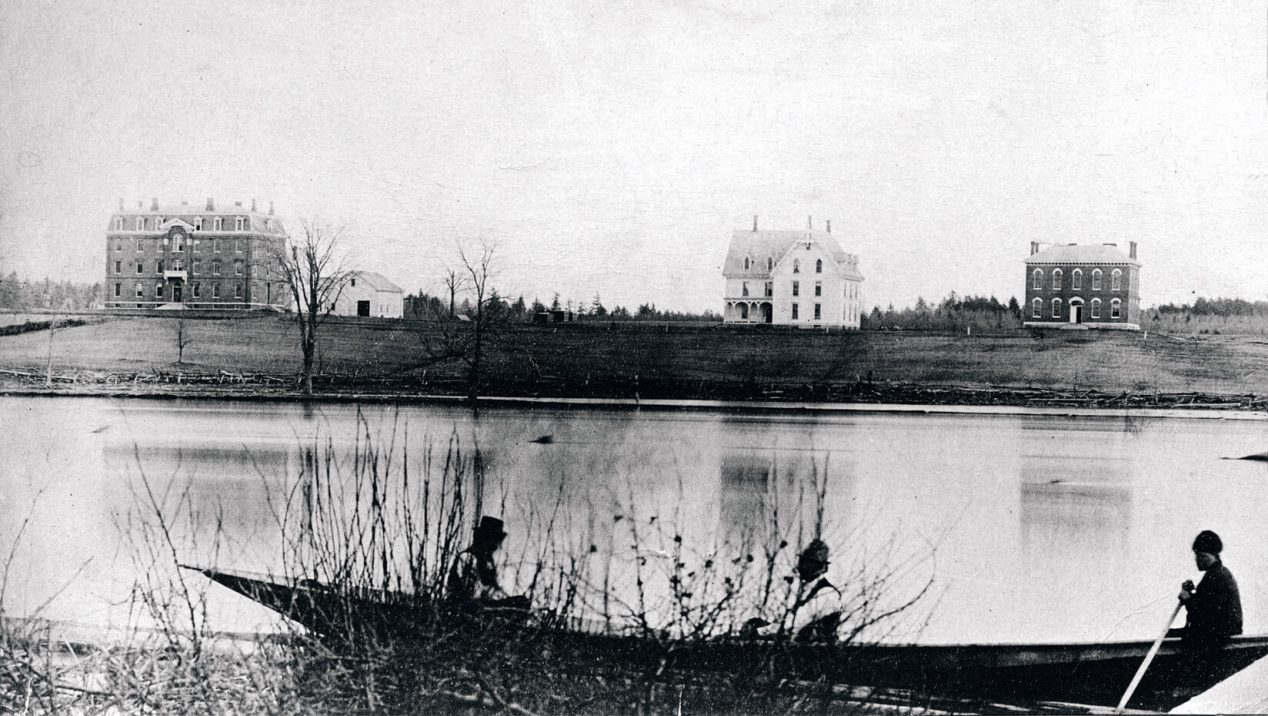
Stillwater River in 1873
1862–1874
- July 1862, President Abraham Lincoln signed into law the Morrill Act sponsored by Vermont Congressman Justin Morrill. The act, also called the Land Grant College Act, provided each state with 30,000 acres of federal land for each member in its Congressional delegation. Maine received 210,000 acres.
- The sale of the 210,000 acres yielded an endowment of $118,300 to fund the Maine State College of Agriculture. The MSC was intended to promote the education of agriculture and the mechanical arts “without excluding other scientific and classical studies, and including military tactics.”
- Cornell University and the Massachusetts Institute of Technology also were among the 69 colleges funded by act.
- In February 1865 — the same year President Lincoln was assassinated, the American Civil War ended and the Thirteenth Amendment to the United States Constitution was ratified, abolishing slavery — Maine Gov. Samuel Cony signed a legislative act that created the Maine State College of Agriculture and the Mechanic Arts.
- In “History of the University of Maine” Merritt Caldwell (M.C.) Fernald wrote that the Morrill Act altered the course of higher education as it “sought … a closer correlation than hitherto had existed, between the brain and the hand, between theory and practice…”
- In January 1867, landscape architect Frederick Law Olmsted sent his Architect’s Report to the college’s Board of Trustees. He described his visit to campus and his suggestions for a “village-like arrangement” for four classes of 40 students each.
- In 1867–68, White Hall was the first college hall built on campus. (A couple of farm buildings also existed.) The three-story wood building had six rooms per floor.
- Maine State College opened Sept. 21, 1868, with 12 students and two faculty members. M.C Fernald was paid $1,200 a year as professor of mathematics and physics. He later became acting president as well. Samuel Johnson was paid $900 annually to be farm superintendent and agriculture instructor.
- To be admitted, males had to be at least 15 years old and pass an exam that included arithmetic, geography, English, grammar, United States history and algebra as far as quadratic equations.
- In December 1868, the first college catalogue read: “The State Industrial College proposes to give to the young men of the State who may desire it, at a moderate cost, the advantages of a thorough, liberal and practical education. It proposes to do this by means of the most approved methods of instruction, by giving to every young man who pursues the course of study, an opportunity practically to apply the lessons learned in the class-room, and by furnishing him facilities for defraying a portion of his expenses by his own labor.”
- Students worked as many as three hours per day five days per week. The labor was “designed to be, in the fullest sense possible, educational.”
- In 1868, the farm produced 90 tons of hay, 1,100 bushels of potatoes and 85 bushels of barley. Students dug 70 bushels of the potatoes to cut the cost of their board from $3 to $2 per week.
- During the first decade, each college year consisted of three terms. The first began in September and the third ended in August.
- First-year first-term courses were algebra, history, physical geography and rhetoric. Second-term courses were algebra, history, botany, physical geography, bookkeeping and rhetoric. Third-term courses were geometry, botany, horticulture, natural philosophy and rhetoric.
- Attendance at chapel was mandatory.
- In 1871, the Rev. Charles Frederick Allen became college president. Curricula were organized into Agriculture, Civil Engineering, Mechanical Engineering and Electives.
- Feb. 23, 1872, a law was passed making the college coeducational. Later that year, Louise Hammond Ramsdell of Atkinson, Maine, became the first female student; she was admitted with junior standing.
- Also in 1872, six students — Benjamin Gould, George Hammond, Edwin Haskell, Heddle Hilliard, Eber Tomas and George Weston — earned diplomas at the first commencement, which was held at a church in Orono.
- In 1874, Ramsdell became the first woman to graduate from the college. Chemistry was added as a class, the first fraternity — Q.T.V. — was founded and a monthly student publication titled the College Reporter was published.
